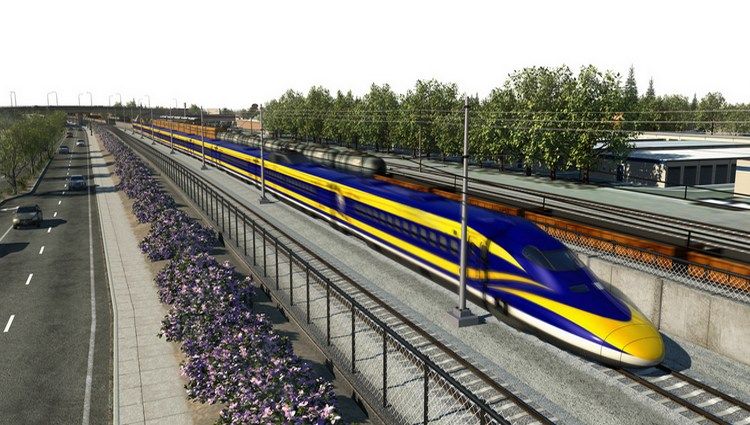High-Speed Rail Authority wins time in case brought by landowners
 A judge has denied a claim filed by opponents of California’s high-speed rail project, saying that while they raised compelling questions about the project’s viability, the project has not progressed enough for the court to evaluate their claims.
A judge has denied a claim filed by opponents of California’s high-speed rail project, saying that while they raised compelling questions about the project’s viability, the project has not progressed enough for the court to evaluate their claims.
The March court ruling suggests that plaintiffs could renew their legal challenge once the authority finalizes its funding plan to trigger use of state bond money. [Court ruling can be found at the bottom of the page.] Plaintiffs have not announced if they will appeal the court’s decision. The authority can use federal tax dollars to purchase land in the meantime, and has purchased more than a third of the 1,505 parcels needed, according to authority documents.
Incompatible with bond measure
Plaintiffs, including Kings County and other landowners affected by the project, argued that the authority’s plan is contrary to what was sold to the voters. Plaintiffs said the authority’s estimated train speeds, funding mechanisms and plan to use existing tracks don’t comply with the bond measure that funded the project.
Voters in 2008 approved $9.95 billion in bonds to fund the rail service from Southern California to Sacramento and the San Francisco Bay Area. The rail project faces other legal challenges focused on the state’s use of cap-and-trade proceeds.
Sacramento County Superior Court Judge Michael Kenny ruled that project opponents’ allegations were premature. The case, originally filed in 2011, questioned whether the authority was complying with the 2008 Prop. 1A bond measure.
Project opponents questioned three promises: whether an express train can travel from Los Angeles to San Francisco in two hours and 40 minutes, whether the project is financially viable and whether a plan to share existing tracks and facilities was permitted by the bond measure.
Though the judge ruled that the case was premature, he hinted that there were potential problems with evidence presented by the Rail Authority.
Attorney Stuart Flashman believes that what the judge said “fired a shot across the bow,” warning the Rail Authority that he had issues with travel times required in Prop. 1A, particularly through the peninsula between San Francisco and San Jose. Trains must be able to travel that segment in 30 minutes or less.
Revised trip times
In January 2013, the authority’s consultants estimated trip times of 30 minutes at 125 mph or 32 minutes at 110 mph, according to the court ruling. A month later, a revised memo listed a faster time, 30 minutes at 110 mph.
“There is no clear explanation for this change in conclusions,” the ruling says.
The judge also warned the Rail Authority that they used the wrong location in San Francisco.
The Rail Authority used 4th and King instead of Transbay Terminal as the northern point to measure the 30-minute travel time to San Jose. The difference from 4th and King to Transbay Terminal is 1.3 miles but a very slow and expensive gap. It has twists and turns, which will greatly restrict speed and which experts estimate could cost as much as $4.5 billion.
Deputy Attorney General Susan O’Grady argued that Prop. 1A did not indicate that Transbay Terminal was the northern measuring point for travel time. The judge disagreed.
Additional challenges
There are many other challenges that the Rail Authority must meet in the immediate future. Its newest business plan, released in February, changed construction direction. While still starting in the Central Valley, construction would now extend north instead of south.
Two lawsuits are pending concerning the rail project’s use of funds from the state’s cap-and-trade program. One, presented by the Pacific Legal Foundation, challenges the program’s existence since it did not pass by a two-thirds vote. The foundation considers the cap-and-trade proceeds an improper tax. The other suit, brought by the nonprofit group TRANSDEF, argues the project is ineligible since it will take decades for it to offset the greenhouse gases it produces as it is built. Assembly Bill 32, the state’s sweeping climate change policy passed in 2006, requires a reduction of greenhouse gases to 1990 levels by 2020, and the first high-speed rail segment will not be operational until 2025.
Related Articles
Top CA GOP senator backs bilingual ed
A notable Golden State Republican just made a U-turn on 16 years of education policy: Sens. Bob Huff, R-Diamond Bar. He jointed majority Democrats in
Trump incites divisive opinions in CA
On the strength of an explosive presidential campaign that has pushed him out to an early lead in some polls
Bill tightening vaccine rules advances as measles fears build
Despite furious opposition from parents who believe vaccinations are dangerous, a measure by state Sen. Richard Pan to tighten up




